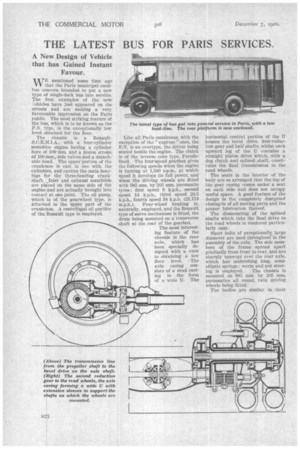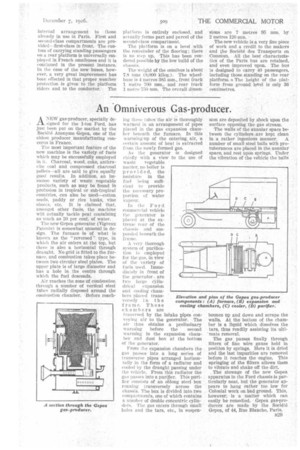THE LATEST BUS FOR PARIS SERVICES
Page 54

Page 55

If you've noticed an error in this article please click here to report it so we can fix it.
A New Design of Vehicle that has Gained Instant Favour.
.vvE mentioned some time ago that the Paris municipal omnibus concern intended to put a new type of single-clock bus into servfice. The first examples of the new vehicles have just appeared on the streets and are making a very favourable impression on the Paris public. The most striking feature of the bus, which is to be known as the -P.N. type, is the exceptionally low level obtained for the floor.
The chassis is a Renault with a four-cylinder anonobloc engine having a cylinder bore of 100 mm. and a piston stroke. Of 160 ram., side valves and a detachable head. The upper portion of the crankcase is cast in one with the cylinders, and carries the main bearings for the three-bearting crankshaft. _Inlet and exhaust manifolds are placed on the same side of the engine and are actually brought into contact at one point. The oil pump, which is of the gearwheel type, is attached to the upper part of the crankcase. A centrifugal oil purifier of the Renault type is employed.
Like all Paris omnibuses, with the exception of the "express" ones, the P.N. is an overtype, the driver being seated beside the engine. The clutch is of the inverse cone type, Ferodolined. The four-speed gearbox gives the following speeds when the engine is turning at 1,500 r.p.m., at which speed it develops its fun power, and when the driving wheels are fitted with 985 mm. by 205 mm. pneumatic tyres: first speed 9 k.p.h., second speed 14 k.p.h., third speed 20.5 k.p.h., fourth speed 34 k.p.h. (21.124 m.p.h.). Four-wheel braking is, naturally, employed, and the Renault type of servo mechanism is fitted, the drum being mounted on a transverse shaft at the rear of the gearbox.
The most interesting feature of the chassis is the rear axle, which has been specially designed with a view to obtaining a low fioor level. • The axle casing consists of a steel casting in the form of a wide U. The horizontal central portion of the U houses the bevel drive, first-reduction gear and half shafts, whilst each upward leg of the U contains a straight pinion drive which, with a dog clutch and splined shaft, constitutes the final transmission to the road wheels.
The seats in the interior of the body are so arranged that the top of the gear casing comes under a seat on each side and does not occupy awful space. A good feature of the design Is the completely dustproof closing-in of all moving parts and the proper lubrication thereof.
The dismounting of the splined shafts which take the final drive to the road wheels is rendered particularly easy.
Short bolts of exceptionally large diameter are used throughout in the assembly of the axle. The side members of the frame spread apart gradually from front to rear, and are sharply upswept over the rear axle, which has underslung long, semielliptic springs; worm and nut steer
ing is employed. The chassis is mounted on 985 mm. by 205 mm. pneumatics all round, twin driving wheels being fitted.
The bodies are similar in their
internal arrangement to those already in use in Paris, First and second-class compartments are provided----first-elass in front. The &stem of carrying standing passengers on a rear platform is universally employtsi in French omnibuses and it is continued in the present instance. In the case of the new buses, however, a very great improvement has been effected in that proper weather protection is given tethe platform riders and to the conductor. The
platform is entirely enclosed, and actually forms part and parcel of the second-ciass compartment.
The pia tform is on a level with the remainder of the flooring; there is no step up. This has been rendered possible by the low build of the eliassis. •
l.`tie weight of the omnibus is about 7.8 tons (8,000 kilog.). The wpeelbase is 4 metres 385 mm., front track 1 metre 700 inm., and ,rear track 1 metre 750 min. The overall dimen
sions are 7 metres 95 mm. by 2 metres 120 mm.
The new vehicle is a very fine piece of work and a credit to the makers and the Socielk des Transports en Commun. All the best characteristics of the Paris bus are retained, and even improved upon. The bus is designed to carry 40 passengers, including those standing on the rear platform.* The height of the platform from ground level is only 36 centimetres.




















































































































